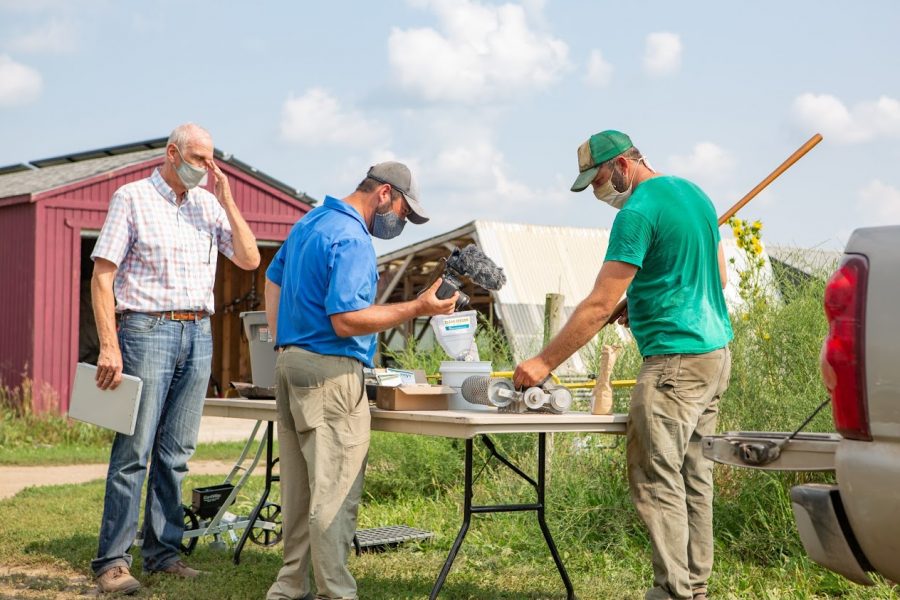Check into Zoom University
A professor films a video for his online agriculture class at the Student Sustainable Farm on Aug. 25. Both students and professors had to adapt to the changes brought about by COVID-19.
September 8, 2020
As we leave the dog days of summer behind to head back to school, everything is looking a bit different this year. Many students across America have traded in physical schools for online alternatives. Thanks to technology, a laptop screen can easily transform into a classroom. The substantial shift to remote learning has been frustrating and discouraging for many teachers across America. This was even more so for those that have had prior issues with weak internet access, less than perfect online student engagement and outlandish technical problems. However, having to shift everything online has had many teachers reporting that their skills with technology in the classroom are improving. Though frustrated with online learning, many teachers have had considerable growth in improving their teaching through technology. Many educators have created video lectures or websites for their courses that provide necessary class materials without requiring in-person interactions. These newfound skills and comfort with other online resources in the classroom may even remain in use when buildings do reopen.
When it comes to the students, many have mixed opinions about fully online instruction. These feelings ring true, especially for students that require in-person labs to learn their craft. Alyse Ruda, a senior in speech and hearing sciences, relies on in-person courses to receive experience within her field. When asked about changes made to her discipline, Ruda mentioned that her experience in clinicals and gaining observation hours have changed the most. Usually, she would be working with the patient in a hands-on environment to learn and understand the systems and machines used in her field. However, this is now all online, with students in virtual attendance for an hour a week. While this alternative has been great to properly social distance and keeps students safe, there are also some downsides. Ruda explained that in an online setting, it is harder for professors to see students’ reactions to the material and gauge their level of understanding. Along with that, many of her professors have had difficulties utilizing the technology for these observations, which has affected class time. However, it is more convenient to host these experiences online, so perhaps virtual clinics are here to stay.
Connor Tenny, junior in industrial engineering, noted that his professor’s ability to adapt and curate online courses was impressive. Industrial engineering is tough enough in person, so Tenny was originally skeptical about the transition to online learning. When asked about his experience thus far, Tenny mentioned while he was impressed with his professors’ abilities, it has been a little hard.
“Some of my professors have no prior background with resources like Zoom,” Tenny said. “So some lectures have been hard to follow.”
However, as a result of COVID-19, Tenny says he has noticed an increase in collaboration between students. In the classroom, it can be easier to avoid interacting with other students, but on Zoom, the silence between you and another person is just plain awkward. Breakout rooms and other mediums have become a way for students to connect despite their location. Tenny mentioned he would love to see the continued use of these mediums. When asked about how he thinks COVID-19 will change technology in the classroom forever, Tenny said we may see an increase in colleges introducing the possibility for more hybrid options in the future. Along with this, Tenny discusses how solutions created as a result of COVID-19 prove that people can get an equivalent education regardless of where the classroom resides. This could make one wonder if there will be an increase in those pursuing online degrees and if the stigma surrounding online education will subside.
Get The Daily Illini in your inbox!
One of the downsides to moving online is its accessibility. While some students have access to their own laptops and devices at home, others do not. With libraries closed or implementing restricted hours as a result of the pandemic, those who need access to computers are struggling. Along with this, some students learning from home may not have the best workspaces. This creates a divide in how accessible it is to fully move courses online, especially when looking towards the future. The coronavirus pandemic has already impacted the way we use technology in the classroom. It will be interesting to see how we, as a society, come to change in a post-COVID-19 world.







